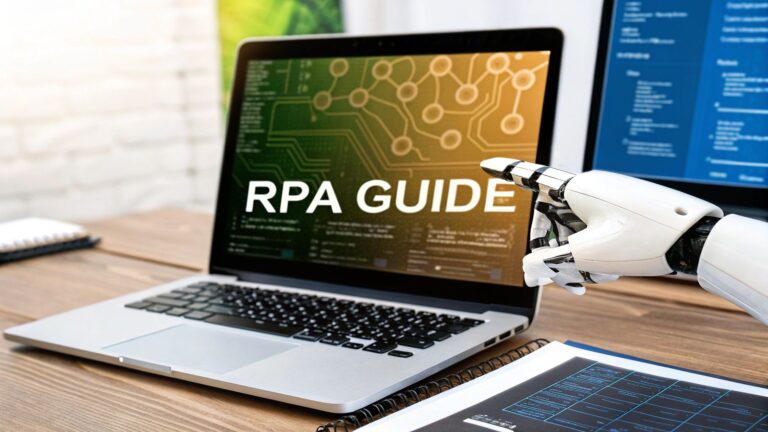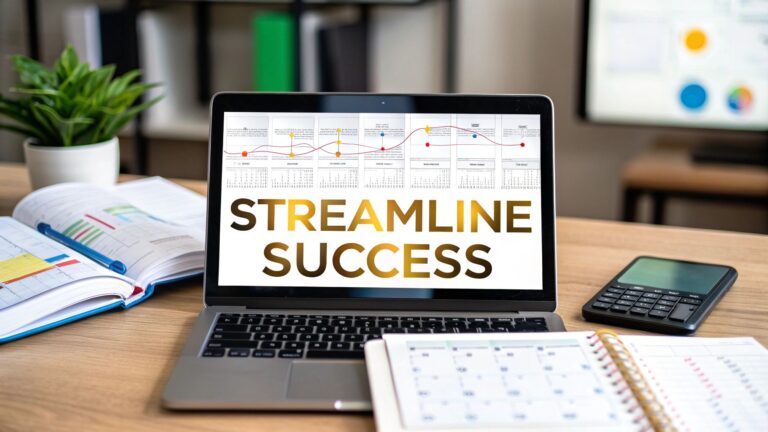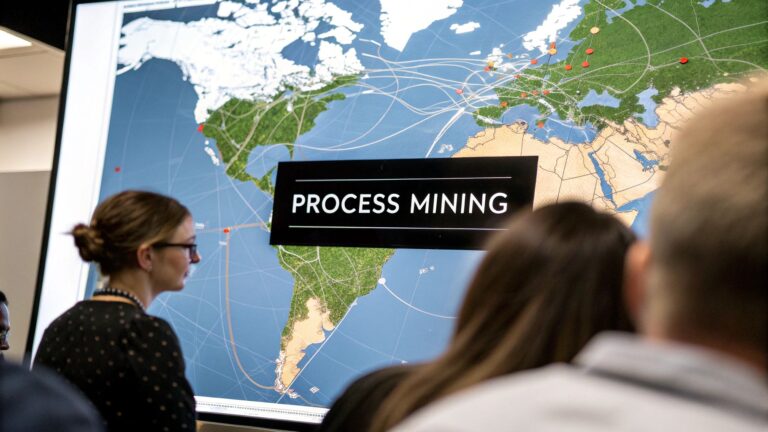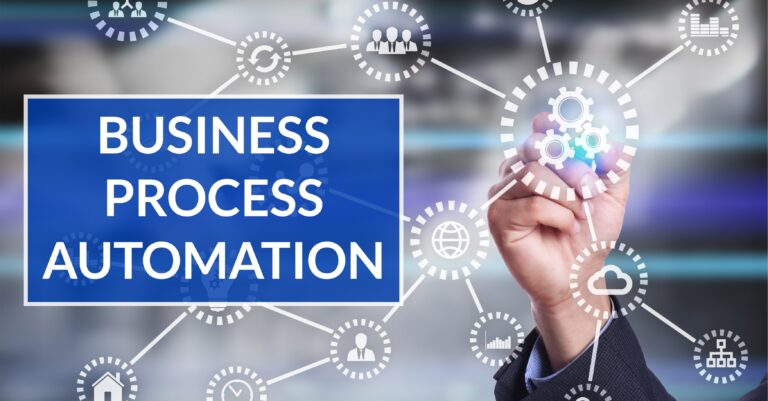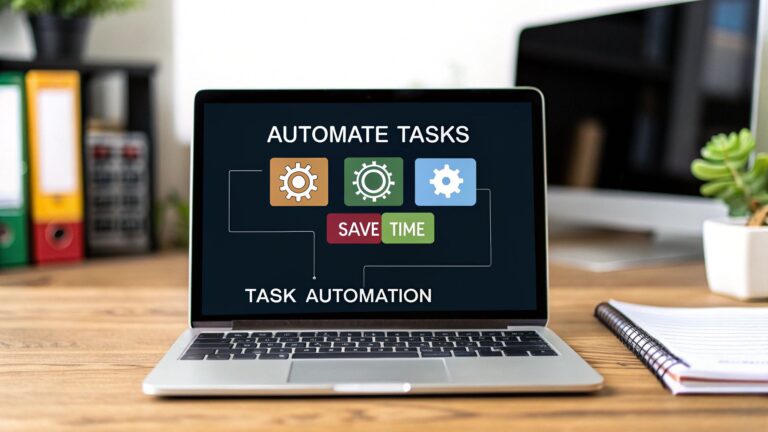Decoding SaaS Customer Acquisition Cost
Let's get straight to it. Your SaaS customer acquisition cost (CAC) is the total amount of money you spend to land one new paying customer. It’s everything you invest in sales and marketing to convince someone to sign up for your software.
Think of it like this: CAC is the price tag on each new customer you win. Getting a firm grip on this number is absolutely crucial for building a business that’s not just growing, but is actually profitable and built to last.
What Is SaaS Customer Acquisition Cost Anyway?
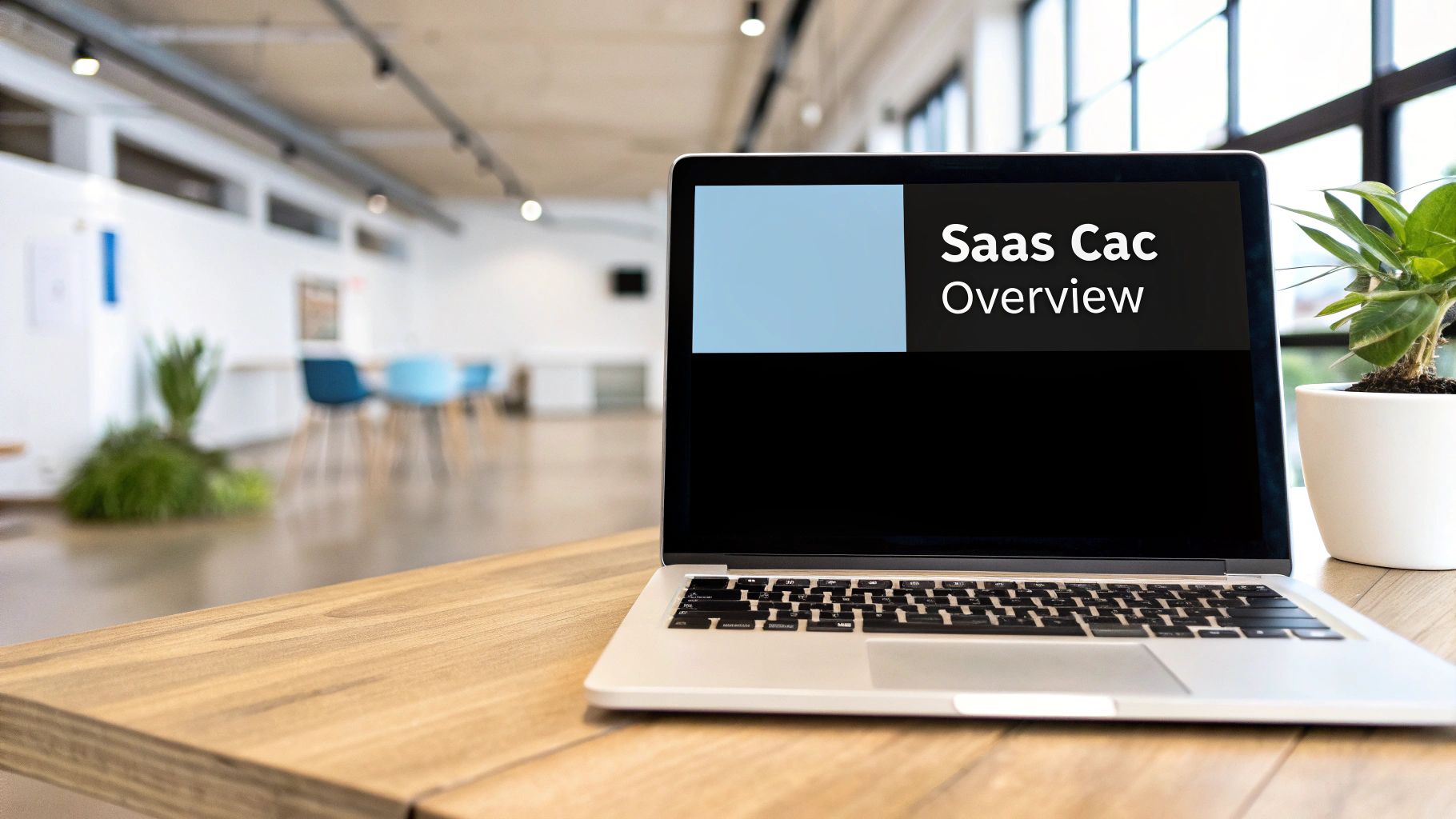
At its heart, your SaaS Customer Acquisition Cost isn't just another line item on a spreadsheet. It’s a vital sign for your company's health and its potential to scale. It answers one simple, yet profound question: "On average, how much does it cost us to get a new customer through the door?"
That single number gives you a surprisingly clear view into how well your sales and marketing machine is running. For founders and investors, it's one of the first things they look at to judge a company's long-term viability. A low and steady CAC screams efficiency, while one that's climbing can be a red flag, hinting at things like market saturation or wasteful spending.
It's an Investment, Not Just an Expense
One of the biggest mistakes I see founders make is treating CAC purely as a cost to be minimized. That’s a limited view. A much healthier way to look at it is as a direct investment in your company's growth.
Every dollar you put into acquiring a customer is a strategic bet that their future subscription payments will deliver a solid return. This simple shift in mindset changes the internal conversation from "How do we slash our budget?" to "How can we invest more intelligently to attract higher-value customers?"
Your CAC isn't just a metric to watch; it's a lever you can pull. When you understand what goes into it, you can fine-tune your entire growth strategy. You ensure every marketing dollar becomes an investment in sustainable revenue, not just a sunk cost.
This is often what separates the SaaS companies that make it from those that fizzle out. The winners don't just track their CAC—they obsessively manage it. They know the delicate dance between what they spend and the quality of the customers they attract, constantly tweaking the balance to expand without burning through cash.
Why Your Whole Company Should Care About CAC
Even though CAC is born in the sales and marketing departments, its shockwaves are felt everywhere else. A bloated CAC can squeeze the life out of your finances, leaving less money for product development, engineering, or customer success. On the flip side, a well-managed CAC frees up capital that can be poured back into innovation and creating a better customer experience.
Here’s a quick breakdown of why it matters to everyone:
- Marketing: It’s the ultimate report card for campaign performance and ROI. It tells you which channels are goldmines and which are money pits.
- Sales: It puts a spotlight on the efficiency of your sales cycle. This includes everything from salaries and commissions to the cost of the tools your team needs to close deals.
- Product: A stubbornly high CAC might point to a product-market fit problem. It could be a sign that the product just isn't resonating enough to make the sale an easy one.
- Finance: This is a cornerstone metric for all financial models. It’s essential for forecasting profitability, figuring out your cash runway, and knowing how much capital you need to grow.
In the end, understanding your SaaS customer acquisition cost is about creating a predictable, repeatable, and scalable way to grow your business. It's what separates companies built on a shaky house of cards from those built on a solid foundation. When you truly get this metric, you can make smarter decisions, put your resources where they’ll have the most impact, and build a company that's meant to last.
How to Accurately Calculate Your SaaS CAC
Figuring out your Customer Acquisition Cost (CAC) seems easy at first glance. Just divide what you spent by the number of new customers you got, right? If only it were that simple.
A quick, back-of-the-napkin calculation can give you a dangerously misleading number, leading you straight into bad decisions about your budget and growth strategy. To get a figure you can actually build a business on, you need to dig much deeper.
The core formula is indeed straightforward: Total Sales and Marketing Expenses ÷ Number of New Customers Acquired = CAC. The real trick is getting an honest, complete picture of your "total expenses" and accurately counting those "new customers" within a specific timeframe.
The Basic CAC Formula
Let's start with a simple example. Imagine a SaaS company called "SyncUp" spends $10,000 on sales and marketing in one month. In that same month, they bring in 100 brand-new customers.
The basic math looks like this:
$10,000 (Total Spend) / 100 (New Customers) = $100 CAC
This number gives you a quick snapshot, but it’s far from the whole story. It completely ignores major hidden costs and paints a far rosier picture than reality. Think of it as a starting point, not the finish line.
To get to the truth, you have to embrace a "fully-loaded" CAC model. This means accounting for every single dollar that goes into winning a new customer—not just the obvious ad spend.
Moving to a Fully-Loaded CAC Calculation
A fully-loaded SaaS CAC includes all the direct and indirect costs tied to customer acquisition. It's the most honest measure of your financial efficiency and the exact metric that savvy investors and experienced leaders rely on.
So, what exactly needs to go into your expense bucket? The details matter. The table below breaks down all the costs you absolutely must include for an accurate calculation.
Essential Components of a True SaaS CAC Calculation
A detailed breakdown of all the sales and marketing expenses required for an accurate and comprehensive SaaS CAC measurement.
| Expense Category | Specific Costs to Include | Why This Component Is Critical |
|---|---|---|
| People Costs | Gross salaries, commissions, and bonuses for your entire sales and marketing teams. | This is often the single largest expense in acquisition and is too frequently overlooked in basic calculations. |
| Advertising Spend | All money spent on platforms like Google Ads, LinkedIn Ads, social media campaigns, and other paid channels. | These are your most direct acquisition costs. Understanding metrics like Google Ads Cost Per Action is vital. |
| Software & Tools | Subscriptions for your marketing automation, analytics, and sales enablement software. | The tech stack that powers your acquisition engine has a real cost that must be factored in. Finding the best CRM for SaaS startups is a key part of this. |
| Creative & Content | Payments to freelance writers, designers, video producers, or any agencies creating marketing assets. | High-quality content isn't free. The costs to create the assets that attract customers belong in your CAC. |
| Overhead Allocation | A portion of general business overhead (e.g., office rent, utilities) attributed to sales and marketing. | Your acquisition teams don't operate in a vacuum. They use company resources that carry a cost. |
By including every one of these components, you move from a vanity metric to a truly actionable one that reflects the real-world cost of growth.
This infographic breaks down the simple three-step process for getting to your true CAC.
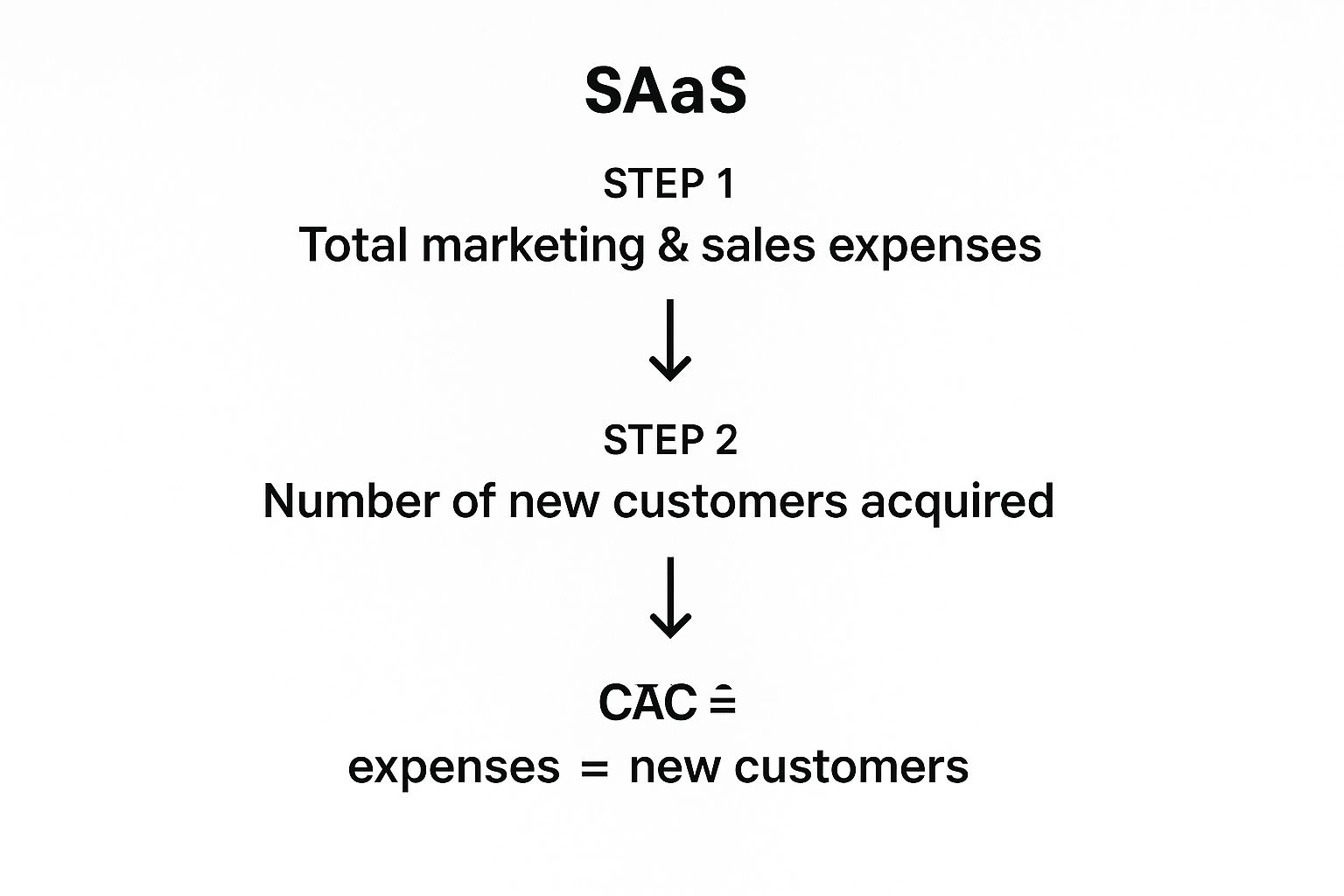
As you can see, the first step is gathering all the relevant expense data before you even think about dividing.
Let's go back to our SyncUp example, but this time, we'll use a fully-loaded approach for the same month.
- Sales & Marketing Salaries: $25,000
- Ad Spend: $10,000
- Software Subscriptions: $2,000
- Freelance Content Costs: $3,000
- Total Fully-Loaded Cost: $40,000
Now, let's redo the math with the same 100 new customers.
$40,000 (Fully-Loaded Spend) / 100 (New Customers) = $400 CAC
The difference is staggering. The basic calculation gave us a feel-good $100 CAC, but the fully-loaded model reveals the true cost to acquire a customer is $400. This four-fold increase isn't just a number—it's the honest truth you need for smart planning, effective budgeting, and a real assessment of your acquisition engine's health.
Benchmarking Your CAC Against Industry Standards
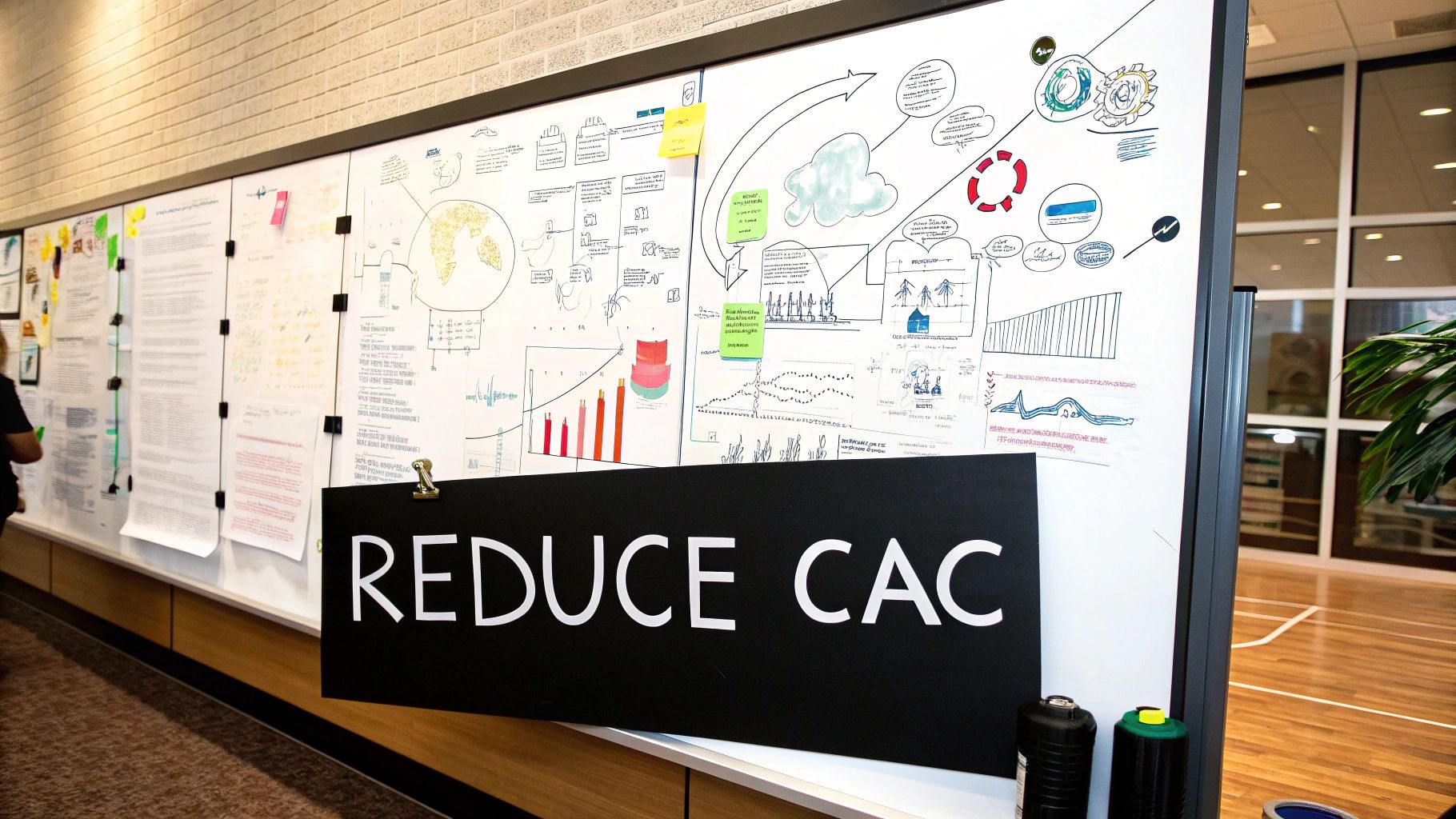
So, you’ve done the heavy lifting and calculated your fully-loaded SaaS customer acquisition cost. You have a number. Now what? Is a $400 CAC a reason to pop the champagne or a five-alarm fire? The honest answer is: it depends.
On its own, your CAC is just a number floating in a spreadsheet. It only becomes a powerful strategic tool when you give it some context. This is where benchmarking comes in—you need to see how your number stacks up against the rest of the industry.
Comparing your performance to your peers helps you set realistic growth targets, justify your marketing budget to the board, and spot red flags before they become serious problems. It’s what turns a simple metric into a clear signal of how efficiently you’re operating in the market.
Why There Is No Universal “Good” CAC
One of the first things you need to get straight is that there’s no magic number for a "good" CAC that works for every SaaS company. What’s perfectly healthy for one business could be a death sentence for another. The right number for you is completely tied to your market, your business model, and ultimately, how much your customers are worth.
Several key factors are at play here:
- Target Market: Selling to small businesses (SMBs) almost always has a lower CAC than selling to large enterprises. Enterprise sales cycles are long, complex, and require far more resources to close a deal.
- Product Price Point: If you’re selling a $29/month subscription, you simply can't afford the same acquisition cost as a company selling a $50,000 annual contract. It’s a completely different ballgame.
- Sales Model: A self-service, product-led growth company is built for a low CAC. In contrast, a high-touch model that depends on a team of account executives will naturally have a much higher cost per customer.
Understanding these differences is crucial. Don't fall into the trap of comparing your enterprise SaaS CAC to a low-touch SMB tool—it's like comparing apples to oranges and won't give you any real insight.
Comparing Your CAC to Industry Averages
While a one-size-fits-all benchmark is a myth, you can find incredibly valuable data by looking at averages within your specific industry. This gives you a much clearer picture of what’s normal and what’s considered efficient in your corner of the world.
For instance, broader data suggests the average SaaS customer acquisition cost is around $702. But that number gets way more interesting when you dig into specific niches. Fintech SaaS companies, for example, often face a staggering average CAC of $1,450 thanks to fierce competition and heavy regulation. Meanwhile, B2B platforms in other verticals might average closer to $500. You can find more of these SaaS industry averages on Userpilot.com.
By looking at these benchmarks, you can get a gut check on your own performance. Are your costs in line with, better than, or worse than your direct competitors? A CAC that's way off the mark could point to major inefficiencies in your marketing channels or sales process.
This kind of comparative analysis is the foundation of smart strategic planning. If your CAC is double the industry average, it’s a bright red flag telling you to figure out why. Are you dumping money into the wrong ad channels? Is your sales team not as productive as it could be? Finding the answers is how you start to optimize.
Using Benchmarks to Drive Strategy
At the end of the day, benchmarks aren’t about feeling good or bad about your numbers; they’re a call to action. Once you know where you stand, you can use that information to make smarter decisions about your entire growth strategy.
If your CAC is well below the industry average, that might be your green light to invest more aggressively and gobble up market share. On the flip side, if your CAC is too high, it’s time to shift your focus to efficiency. That could mean anything from improving your website's conversion rates to tightening up your ideal customer profile. It’s often crucial to refine how you qualify leads, and exploring some lead scoring best practices can make a huge difference here.
Think of benchmarks as a compass for your business. They won’t draw the map for you, but they will point you in the right direction for building a more profitable and sustainable company.
The LTV to CAC Ratio: Your Ultimate SaaS Health Metric
Figuring out your SaaS customer acquisition cost is a great first step, but it only gives you half the picture. Knowing how much you spend to land a new customer is pretty useless until you know what that customer is actually worth to you over their entire relationship with your business. That’s where CAC’s essential partner, Customer Lifetime Value (LTV), comes into play.
Think of it like this: your CAC is the upfront investment to win a customer. Your LTV is the total revenue they’ll bring in before they churn. The relationship between these two—the LTV to CAC ratio—is arguably the single most important metric for understanding the long-term health and sustainability of your SaaS company.
This ratio gives you a brutally honest look at how profitable your entire customer acquisition machine really is. It answers the one question that matters most: for every dollar we put in to get a new customer, how many dollars do we get back?
What Does a Healthy Ratio Actually Look Like?
For any SaaS business to be healthy and scalable, a customer’s value must be much higher than the cost to acquire them. The gold standard everyone shoots for is a healthy LTV to CAC ratio of 3:1 or better, but what do the different numbers really mean?
Let’s break it down:
- 1:1 Ratio: This is a major red flag. You're spending a dollar to make a dollar. Once you account for all your other costs—like R&D and general overhead—you're actively losing money.
- Less than 3:1 Ratio: This points to some serious cracks in your business model. Maybe you're overspending on acquisition, customers aren't sticking around long enough, or your pricing is just too low. It's a sign your growth engine is sputtering.
- 3:1 Ratio: You’ve hit the sweet spot. A 3:1 ratio indicates a solid, profitable, and sustainable business. You're efficiently acquiring customers who stay long enough to deliver a healthy return on your investment.
- 4:1 or Higher: Now we're talking. A ratio this high signals an incredibly efficient growth model. It means you have plenty of cash to reinvest into more aggressive sales and marketing to really step on the gas and grab more market share.
This simple number cuts through all the noise and gives everyone—your team, your board, your investors—a clear and immediate snapshot of your capital efficiency.
Why This Ratio Is Such a Powerful Strategic Tool
The LTV to CAC ratio isn't just a report card on past performance; it's a compass for your future strategy. It gives you deep insights into what really drives your business, showing you which areas need fixing and which opportunities you should double down on.
For example, history has shown us that this ratio is critical for judging the financial health of SaaS companies. We also know from research that acquisition costs aren't one-size-fits-all—they change dramatically based on who you're selling to. Small businesses, mid-market companies, and large enterprises each have their own CAC challenges. Enterprise CAC can swing wildly from $2,190 in eCommerce to a staggering $14,772 in Fintech, which just goes to show how vital a tailored go-to-market strategy is. You can dig into more data on how CAC varies across business types and markets on eqvista.com.
When you consistently track your LTV to CAC ratio, you're no longer just guessing about your performance. You have a powerful metric that connects your marketing spend directly to long-term profitability, showing you precisely where to focus your efforts for maximum impact.
If your ratio is too low, you know you have two main levers to pull: either drive down your CAC or push up your LTV. This clarity lets you focus your team on what matters most, whether it's fine-tuning your marketing channels to lower acquisition costs or improving your product and customer success to boost retention. It turns a complex business problem into a clear, actionable mission.
Proven Strategies to Lower Your SaaS CAC

Knowing your SaaS customer acquisition cost is the first step. The real magic happens when you start actively pushing that number down. Lowering your CAC isn't about gutting your marketing budget; it's about being smarter with every dollar you spend.
This means shifting your mindset from just getting more customers to getting the right customers as efficiently as possible. These strategies are a practical playbook for fine-tuning your acquisition engine, boosting your unit economics, and building a far more profitable company.
Double Down on Conversion Rate Optimization
One of the quickest ways to slash your CAC is to get more out of the website traffic you already have. What's the point of pouring more money into ads if your landing pages are leaking potential customers? This is where Conversion Rate Optimization (CRO) becomes your best friend.
CRO is simply the process of improving your site to get more visitors to take a specific action, like starting a trial or booking a demo. Even a tiny improvement in your conversion rate can make a huge dent in your acquisition costs, all without spending another cent on advertising.
Here’s where to start for the biggest impact:
- Simplify Your Sign-Up Form: Be ruthless. Only ask for what you absolutely need. Every extra field is another reason for someone to give up and leave.
- Sharpen Your Call-to-Action (CTA): Your CTA needs to pack a punch. "Get Your Free Demo" is clear and compelling. "Submit" is not.
- Show Off Your Social Proof: Nothing builds trust faster than seeing that other people have already found success with your product. Plaster your site with testimonials, case studies, and customer logos.
Build a Powerful Content and SEO Engine
Paid ads get you results fast, but it’s like renting an audience. The second you stop paying, the traffic spigot turns off. Content marketing and SEO, on the other hand, are about building an asset—a lead-generating machine that works for you 24/7.
It definitely takes more upfront effort, but a solid content strategy is one of the most reliable ways to lower your SaaS customer acquisition cost over the long haul. Why? Because organic leads are looking for you. They're actively searching for a solution, which means they're often more qualified and convert at a much higher rate.
A great place to start is by increasing organic traffic with proven SEO strategies, which helps you rely less on expensive paid channels. This means creating genuinely helpful blog posts, guides, and tools that answer your ideal customer's biggest questions.
By becoming the go-to resource in your niche, you attract customers naturally instead of paying to interrupt their day. This shift from outbound to inbound is the secret to sustainable, low-cost growth.
Turn Your Customers into a Growth Channel
Don't forget your most powerful and overlooked marketing channel: your existing customers. These are people who already know your product, trust your company, and see the value you provide. A smart customer referral program can turn their goodwill into a steady stream of high-quality new leads.
Referrals have one of the lowest CACs you'll ever see. The acquisition cost is usually just a small incentive, like a discount or some account credit. Even better, referred customers tend to stick around longer and have a higher lifetime value because they arrive with a built-in seal of approval from someone they trust.
Creating a referral program that actually works comes down to three things:
- Make It Easy: Give customers a unique link they can share with one click. No hoops to jump through.
- Offer a Double-Sided Incentive: Reward the person referring and the new customer. It gives everyone a reason to participate.
- Promote It Actively: A referral program won't promote itself. You have to tell people about it through email, in-app messages, and on social media.
Ultimately, these strategies are designed to work together to create a more resilient and efficient growth model. A big piece of that puzzle is your funnel, and exploring different sales funnel optimization strategies can help you plug any remaining leaks. By blending CRO, SEO, and referrals, you can systematically drive down your CAC and set the stage for profitable, long-term growth.
Answering Your Top SaaS CAC Questions
Alright, we’ve covered the formulas, the benchmarks, and the strategies behind SaaS customer acquisition cost. But once the theory sinks in, the real-world questions start popping up. This is where the rubber meets the road, and where leaders often get tangled up in the day-to-day details of managing this all-important metric.
Think of this section as a quick-fire FAQ for those common, crucial questions. We'll give you clear, straightforward answers to help you calculate, interpret, and act on your CAC with more confidence. Let's clear up the confusion and get practical.
How Often Should I Calculate My SaaS CAC?
Finding the right rhythm for calculating your CAC is the secret to making it a genuinely useful metric, not just another number buried in a report. The best frequency really depends on your sales cycle, but for most SaaS businesses, a layered approach is the way to go.
A monthly calculation is your tactical tool. It’s perfect for giving your marketing team a relatively quick feedback loop on their campaigns and channel performance. Did you launch a new ad campaign this month? A monthly CAC check will show you its immediate impact.
But a monthly view can be volatile. One big deal or a slow week for leads can throw the numbers way off. That's why a quarterly calculation is crucial for strategic planning. It smooths out those monthly bumps, giving you a much more stable and reliable view of your acquisition engine’s health. This is the number you should be sharing with your board and using to make high-level budget calls.
A classic mistake is calculating CAC too often, like on a weekly basis. Unless your sales cycle is just a few days long, a weekly number is almost always misleading. You might be looking at this week's marketing spend against leads from a month ago finally closing, which creates a completely distorted picture.
And of course, a full annual review is non-negotiable. This is where you zoom out to spot long-term trends, set intelligent goals for the year ahead, and make major calls on your entire go-to-market strategy.
What Are the Biggest Mistakes When Calculating CAC?
An inaccurate CAC is far more dangerous than no CAC at all. It gives you a false sense of security and leads to terrible decisions. The good news is that the most common—and costly—mistakes are surprisingly easy to sidestep once you know what to look for.
The absolute number one error is forgetting to include salaries. So many teams only count their direct ad spend and tool subscriptions. The reality is, the payroll for your sales and marketing crew is almost always the single biggest expense in acquiring a customer. Leaving it out will give you a dangerously low CAC that doesn't reflect reality.
Another big one is mismatching timeframes. This happens when you take one month's expenses and divide them by a different month's new customers—say, using May's marketing spend against June's customer count. Because of the natural lag in your sales cycle, you have to account for the delay between spending the money and winning the customer.
Here are a few other common traps to be aware of:
- Mixing New and Existing Customers: Your CAC calculation must only count brand-new logos. If you include revenue from existing customers upgrading their plans, you'll artificially deflate your CAC and hide the true cost of acquisition.
- Ignoring Overhead Costs: While startups can often get away with ignoring this, more mature companies should be allocating a portion of general business overhead (like rent and utilities for the S&M teams) into their fully-loaded CAC.
- Not Segmenting CAC by Channel: A blended, company-wide CAC is a great starting point, but it hides what's really going on. You have to calculate CAC for each channel (paid search, content, referrals, etc.) to know where to double down and where to pull back.
Is It Possible for My CAC to Be Too Low?
It sounds crazy, right? But the answer is a definite yes. While a low customer acquisition cost usually signals efficiency, an extremely low CAC can be a warning sign that you’re simply not investing enough in growth. You might be playing it too safe.
Look at your LTV:CAC ratio. The classic benchmark for a healthy SaaS business is 3:1. If your ratio is sitting at 10:1 or even higher, that’s a massive blinking sign that you have plenty of room to spend more aggressively to get customers. You are almost certainly leaving growth on the table by underinvesting.
An unusually low CAC can also mean you're only picking the "low-hanging fruit"—those customers who were already looking for you and were easy to convert. That feels great in the short term, but it often means you aren’t breaking into a wider market or funding the channels that will fuel bigger, more sustainable growth down the road.
The goal isn't to get the lowest CAC possible, no matter what. The goal is to find the optimal CAC that fuels ambitious, profitable, and sustainable growth. It's a constant balancing act between efficiency and aggression.
At MakeAutomation, we build the AI-powered automation and sales frameworks that help SaaS companies scale without the chaos. If you're ready to optimize your workflows, eliminate manual work, and build a more profitable growth engine, see what's possible at https://makeautomation.co.


